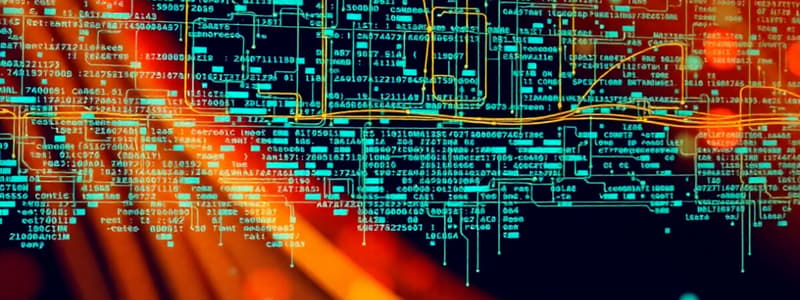Podcast
Questions and Answers
What is the primary function of Transmission Control Protocol (TCP)?
What is the primary function of Transmission Control Protocol (TCP)?
- To connect different local area networks
- To manage flow control and guarantee reliable delivery (correct)
- To transmit data packets over the internet
- To forward messages across multiple networks
Which statement correctly describes the role of Internet Protocol (IP)?
Which statement correctly describes the role of Internet Protocol (IP)?
- IP identifies services running on local machines.
- IP guarantees the reliability of data transmission.
- IP is used for managing information flow between networks.
- IP is primarily responsible for delivering messages from sender to receiver. (correct)
What does a port represent in network communication?
What does a port represent in network communication?
- A routing number for data packets
- An endpoint to identify a specific service (correct)
- A physical connection point on a device
- A unique identifier for a local area network
Which of the following correctly matches an application layer protocol with its function?
Which of the following correctly matches an application layer protocol with its function?
What is a socket in networking terms?
What is a socket in networking terms?
What type of attack involves unauthorized access to information that one is not authorized to see?
What type of attack involves unauthorized access to information that one is not authorized to see?
Which of the following is NOT a category of cyberattacks as described?
Which of the following is NOT a category of cyberattacks as described?
What is the primary aim of a Denial-of-Service (DoS) attack?
What is the primary aim of a Denial-of-Service (DoS) attack?
Which of the following best describes a 'man-in-the-middle' attack?
Which of the following best describes a 'man-in-the-middle' attack?
What does non-repudiation provide in the context of information security?
What does non-repudiation provide in the context of information security?
Which operation is typically NOT associated with Modification attacks?
Which operation is typically NOT associated with Modification attacks?
Shoulder surfing is a method of which type of attack?
Shoulder surfing is a method of which type of attack?
Which layer of the web protocol stack does HTTP operate at?
Which layer of the web protocol stack does HTTP operate at?
Which of the following behaviors describes eavesdropping?
Which of the following behaviors describes eavesdropping?
Which of the following elements is NOT one of the key components of communication?
Which of the following elements is NOT one of the key components of communication?
An example of a repudiation attack is:
An example of a repudiation attack is:
What is the primary function of the Internet layer in the TCP/IP model?
What is the primary function of the Internet layer in the TCP/IP model?
In the context of the protocol stack, what does HTTP primarily govern?
In the context of the protocol stack, what does HTTP primarily govern?
What role does the Transmission Control Protocol (TCP) serve in network communication?
What role does the Transmission Control Protocol (TCP) serve in network communication?
What is the function of the link layer in the TCP/IP model?
What is the function of the link layer in the TCP/IP model?
Which of the following is a characteristic of protocols in the protocol stack?
Which of the following is a characteristic of protocols in the protocol stack?
What does the protocol stack illustrate in terms of communication?
What does the protocol stack illustrate in terms of communication?
Why is it important not to perform attacks against any system without permission?
Why is it important not to perform attacks against any system without permission?
Flashcards are hidden until you start studying
Study Notes
Networking Basics
- Communication involves three elements: source, destination, and transmission medium.
- Protocols set the rules for communication, allowing for interpretation of data.
Network Protocols
- The TCP/IP model describes how protocols operate at different layers and interact with surrounding layers.
- Four layers in the TCP/IP model:
- Application: Data used by users/applications.
- Transport: Manages communication across devices and networks.
- Internet: Transfers datagrams across networks via routers.
- Link Layer: Facilitates local network communication between two hosts.
The Protocol Stack
- Communication requires interaction across multiple protocols, visualized as a hierarchical stack.
- Key protocols in the stack:
- HTTP: Governs interactions between web servers and clients, defining content and format of requests and responses.
- TCP: Manages individual connections and ensures reliable information delivery.
- IP: Forwards messages across multiple networks using routers.
- Ethernet: Handles message delivery within a local area network (LAN).
Comparing Protocols with Human Verbal Communication
- HTTP likened to language used for communication on the web.
- TCP compared to formal greetings, establishing an interaction.
- IP analogized to body language and vocalization.
- Ethernet compared to the physical transmission of sound.
Servers
- Servers utilize various application layer protocols and are identified by IP addresses.
- To communicate with a server, format the address correctly (e.g., http://192.168.1.1:80).
Ports
- Ports serve as communication endpoints to differentiate services on a host.
- Port numbers range from 0 to 65,535 and are managed by the Internet Assigned Numbers Authority (IANA).
- A socket is a combination of IP, protocol, and port, enabling data transmission.
Attacks
- An attack is an intentional maneuver targeting information systems, classified into four categories:
- Access: Unauthorized information access impacting confidentiality.
- Modification: Unauthorized changes to information affecting integrity.
- Denial-of-Service (DoS): Prevents legitimate user access to resources, affecting availability.
- Repudiation: Denies the validity or occurrence of an action.
Access Attacks
- Examples include shoulder surfing, eavesdropping, and interception (such as Man-in-the-middle attacks).
Modification Attacks
- Involve unauthorized information changes, such as insertion, deletion, or updates to data.
Denial-of-Service (DoS) Attacks
- Deny resource access to legitimate users and can include data deletion, encryption, or system disabling.
Repudiation
- Refers to a denial of the truth of an action.
- Non-repudiation is crucial for proving data origin and identity association with actions.
Repudiation Attacks
- Include masquerading (identity theft or spoofing) and denial of event (disavowing a transaction).
HTTP
- HTTP is the core application-layer protocol of the web, operating as a request-response model.
- HTTP/1.1 is widely used, while HTTP/2 is also common.
- It is stateless, with clients (browsers) making requests and servers responding.
- Most critical protocol for web security.
Studying That Suits You
Use AI to generate personalized quizzes and flashcards to suit your learning preferences.




